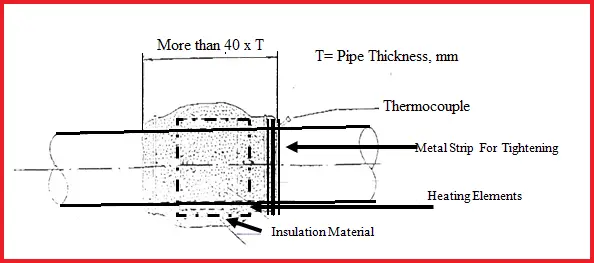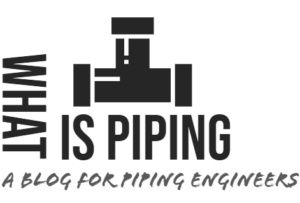

The full form of PWHT is Post-weld heat treatment. PWHT is a controlled process that involves reheating the metal below its lower critical transformation temperature, following a welding process. The material is then held at the elevated temperature for a predetermined period of time to alleviate residual stresses, increase the strength, increase or decrease the hardness, and reduce the risk of cracking by microstructural changes. An array of heating processes can be used to carry out post-weld heat treatment.
This article shall cover PWHT of welded butt joints, branch joints in Carbon Steel and Low Alloy Steel Materials, as well as all types of welded joints in killed carbon steel materials for Low-Temperature Service to guide technicians, supervisors, and other persons involved in the safe execution of PWHT activity so that final result is acceptable.
Post Weld Heat Treatment or PWHT of Carbon Steel must be performed after every welding in order to ensure the material strength of the part is retained. The exact criteria for PWHT of carbon steel are mentioned in the ASME BPVC code. PWHT ensures the reduction of residual stresses, controlling material hardness, and enhancement of mechanical strength.
If PWHT is neglected or performed incorrectly, the residual stresses can combine with service load stresses. The value may exceed a material’s design limitations leading to weld failures, higher cracking potential, and increased susceptibility to brittle fracture.
The power controlling panel of post-weld heat treatment is composed of:
Each panel will supply a single heating station and therefore for each heating operation, one panel will be needed. Heating and cooling rates are adjusted by manual selection of the percentage of power input by means of potentiometers.
Before applying for the detailed PWHT requirements and exemption in these paragraphs, satisfactory weld procedure qualifications of the welding procedures specification to be used shall be performed in accordance with all the essential variables of ASME SECTION IX including conditions of post-weld heat treatment and other restrictions listed below.
READ Major Factors Affecting the Pump PerformanceWhile carrying out local post-weld heat treatment, the technique of application of heat must ensure uniform temperature attainment at all points of the portion being heat treated. Care shall be taken to ensure that the width of the heated band on either side of the weld edge shall not be less than four (4) times pipe thickness or 2″ whichever is greater.
Throughout the cycle of post-weld heat treatment, the portion outside the heated band shall be suitably wrapped under insulation so as to avoid any harmful temperature gradient at the exposed surface of the pipe. For this purpose, the temperature at the exposed surface of the pipe should not be allowed to exceed 400°c.
The valves, instruments, and other special items with welding ends, shall be protected, because of the risk of damage during post-weld heat treatment.
No welding shall be performed after PWHT.
Automatic temperature recorders that have been suitably calibrated shall be employed. The calibration chart of each recorder shall be submitted to the owner prior to starting the heat treatment operations and his approval shall be obtained. Recording equipment shall be calibrated at least once every 12 months. Also, the instrument equipment (potentiometer) which is used for the calibration of recorders should be supported by a related certificate.
After performing a visual inspection and removing surface defects and temporary tack welds (if any) an adequate number of thermocouples (based on the diameter of pipes) shall be attached to the pipe directly and equally spaced location along the periphery of the pipe joint. The minimum number of thermocouples attached per joint shall be 1 for up to 3″ diameter, 2 for up to 6″ diameter, and 3 for up to 10″and 4 for up to 12″diameter and above. However, the required minimum number of thermocouples to be attached can be increased if it is found necessary.
The thermocouples shall be placed on the joint and in firm contact with the pipe as near as possible to the weld area. Thermocouples should be directly tack welded to the joint or heating band jointly provided that they have a tail of the same material and approved filler wire or electrode not larger than 2.5 mm in diameter is used for tack welding.
In order to avoid incorrect temperature readings due to direct radiation to thermocouples, it shall be protected by ceramic fiber blanked or any other suitable insulation material.
Heating resistance elements shall be laid over the attached thermocouples throughout of heating band and shall be insulated as shown in Fig. 1 below.
Insulating materials shall be mineral wool/glass wool which can overcome the temperature employed. The minimum insulation thickness shall be 50 mm. To hold the insulation material in position wire mesh shall be wrapped around and tied or tied by other suitable means.

The post-weld heat treatment temperature and time and its heating and cooling rates shall be recorded automatically and present the actual temperature of the weld area. Each thermocouple shall be connected to the controlling and recording instrument for each treated joint.
The heating temperature above 300°c shall be recorded and the heating and cooling rate shall not be more than that specified in related WPS and standards but in no case, more than 200°c/hr and the difference between the temperatures measured by various thermocouples shall be within the range specified.
READ Tee Connections in Piping | Equal Tee, Reducing Tee | Piping Tee DimensionThe heat treatment soaking temperature and holding time shall be as specified in related welding procedure specifications. For easy reference, the values for different types of steel are given in the following table.
The cooling down to 300°c shall be controlled cooling. Below that the cooling down to ambient temperature shall take place under insulation coating without controlling.

The post-weld heat treatment temperature for ASTM A672, ASTM A234, ASTM A671, and ASTM A420 is generally 635(+/-15) Degrees Centigrade.
ASME B31.3 specifies the PWHT temperatures with respect to the P Number of the material. Table 331.1.1 provides the PWHT holding temperature range. The same is reproduced below (Fig. 3) for your reference.

Additionally, table 331.1.3 provides certain exemptions from mandatory heat treatment. So, both Tables must be refereed concurrently.

Industrial post-weld heat treatment is carried out using different techniques as listed below:
The conductive method of PWWHT uses ceramic fiber, band, snake, and other resistors based on the object dimension, together with precision control, programming, and automatic recording equipment. This method of heat treatment using electrical resistance is a common method for local PWHT in the field.
In this method, Currents induced by high-frequency coils generate the required heat. The generated heat increases the metal temperature as per the PWHT requirement. The number of coils and length of cable needed to achieve the objective is pre-determined.
This method is also known as internal combustion treatment. In the convective post-weld heat treatment technique, the heat generated with the help of gas/diesel burners is transferred to the weld by the convection process. This method is widely used for large objects like pieces of equipment requiring very high power levels. This type of post-weld heat treatment is also recommended for pipe prefabrication works where the processing volume is very high.
PWHT for stainless steel is usually not required. However, to increase the corrosion resistance or reduce stress corrosion cracking susceptibility, stainless steel PWHT may be used depending on the service conditions encountered.
The requirements for PWHT for piping are dependent on the P-numbers and Group numbers of the pipe material. Clause 331.1.1 along with Table 331.1.1 and Table 331.1.2 of ASME B31.3 provides the requirements for PWHT depending on pipe materials. However, if the proper pre-heat temperature is applied during the welding of pipes of specified thicknesses, the mandatory post-weld heat treatment can be exempted. Such rules are provided in Table 331.1.3 of ASME B31.3.
In the following section, I will address some of the most frequently asked questions related to PWHT.
PWHT is an acronym for the full form of Post Weld Heat Treatment.
Most of the conventional welding processes generate residual stresses in the welding regions. These stresses in certain conditions can approach the yield strength of the material. Such joints are prone to failure and can not be used directly. PWHT is applied to such welded steel assemblies to reduce the likelihood of brittle failure. PWHT significantly reduces the residual stresses in the weld joints and thereby reduces the failure potential. So, wherever there is a risk of environmentally assisted cracking, PWHT is required.
The ASME B31.3 PWHT requirements for piping materials are established in clause 331.1.1 along with Table 331.1.1, 331.1.2, and 331.1.3.
PWHT temperature is not calculated. The range of PWHT temperatures is mentioned in tabular formats in the governing codes. So, the PWHT temperature is selected from the tables of the governing code. For example, table 331.1.1 of ASME B31.3 for process piping systems.
Stress-relieving is a process to reduce residual stresses in an object. Heat treatments like normalizing, annealing, quenching, tempering, etc are some of the processes to relieve the residual stresses generated by welding. PWHT is also a process in which stress relief is achieved. However, the main difference between Stress relieving and PWHT is that the stress-relieving can be made at temperatures below the minimum transformation temperature of the steel where no micro-structural change of the material occurs.
I am a Mechanical Engineer turned into a Piping Engineer. Currently, I work in a reputed MNC as a Senior Piping Stress Engineer. I am very much passionate about blogging and always tried to do unique things. This website is my first venture into the world of blogging with the aim of connecting with other piping engineers around the world.
Hi Anup, the article is well explained but one thing is missing which I believe is
“Criteria where PWHT is applicable material/ thickness wise as per ASME31.3” needs to be mentioned like CS pipe with thickness above 20mm etc..
Our Isos usually specifies which line to have PWHT. Appreciate if you cover this vital info.
Best regards
Nikhil Nanivdekar
Mob:- 7718831017
What are the detrimental effects of exceeding the specified heating and cooling rates within the restricted cooling and heating temperatures?
Suvidha says:How many weld joints can be tested with 1 power controlling panel ?
rahmah ramadhani says:What is the maximum time (hours / days) that the PWHT shall be conducted after welding activity ?
Ashutosh Verma says:Hi, Can some one help in understanding the minimum and maximum dwell period required to perform PWHT on a piping joint.
Aliter:
What is the minimum and maximum time after welding of a joint, PWHT can be performed.
whether in offshore structures, I can weld TKY Joints, after stress relieving of parent material.
scott says:learn more information in this article
Ashish prajapati says:PWHT ka code kya hoga
Md Shafayat Islam says:Essential variables of PWHT?
Azamat K says:Hi everybody! I am Welding Inspector
also interesting PWHT
How about to color used in chart, Is it essential based on the code or depends on internal procedure?
Embarking on an interview for a Piping Layout Engineer position is an exciting step in advancing your career in engineering design. This role demands not only a solid foundation in piping design.
Pumps and Compressors are widely used hydraulic machines in chemical, oil & gas, refinery, and petrochemical industries. Both of them even find applications in domestic usage. Both Pumps and.
Hi There! Welcome to my space, I am Anup Kumar Dey, an experienced Piping and Pipeline engineer for the last 20 years. Through this platform, I will share my experiences and knowledge with you in an innovative way. So be with me for the next couple of years!